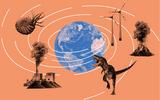MEK – K3 T1 A1 – When life almost disappeared
During the Permian period, diverse forms of life flourished for millions of years. But 252 million years ago, this diversity of life was almost completely wiped out as a result of gigantic volcanic eruptions and subsequent global warming.
Carbon dioxide CO2 emissions from volcanic cracks and burning coal deposits caused the Earth to grow hotter and hotter.
The greenhouse gas also turned the oceans into acid, killing off almost all life. High temperatures and volcanic ash led to massive algal growth – seawater became a toxic soup.
Scientific insights into the past show us that – in contrast to natural disasters – we can do something about man-made global warming.
Martin’s Hole in the Glarus Alps is the scene of a famous natural spectacle: here, on two successive days in March and at the end of September, the sun shines briefly through an opening in the rock face. A mysterious beam then strikes the church spire in Elm and moves on across the landscape.
But there is more to this site than meets the eye: the rock dates back to the Jurassic period, and towering above it are peaks made up of deposits from the much older Permian period.
These are the Tschingelhörner, an alpine attraction bearing witness to an epoch which ended with an unimaginable environmental catastrophe 252 million years ago.
Lying hidden within the Earth are fossils – the petrified remains of animals and plants that lived millions of years ago. During excavations, field workers carefully remove layer after layer to unearth the fossil treasures.
The evidence of past worlds found in this way provides a basis for documenting the evolutionary steps of life on Earth.
Retrieving fossils, extracting them from the surrounding rock and analysing them requires the knowledge and skills of a wide variety of experts.
Research of this kind constantly yields new insights, continuously improving our understanding of the history of life on Earth.
